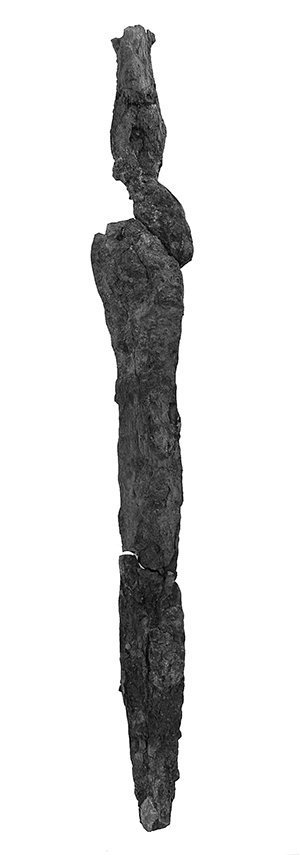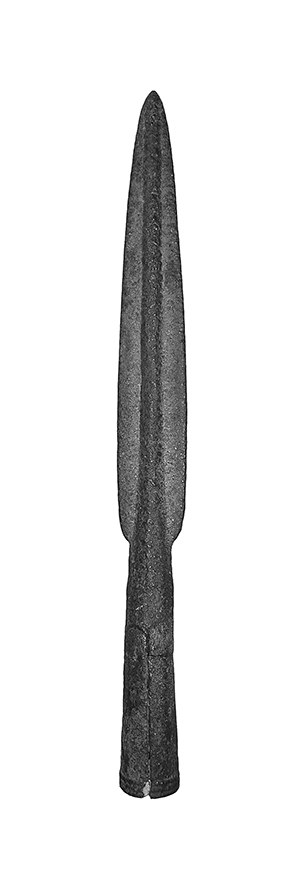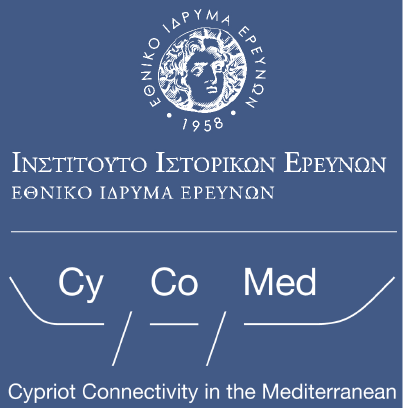Weapons from Cypriot Early Iron Age (EIA) élite burials (LC III B/CG)
Christian Vonhoff †
Research Associate
Department of Archaeological Sciences/Ruhr-University Bochum

Fig. 1 Iron dagger Kourion-Kalorziki T.40
Introduction
Already within the oldest work of occidental literature – the Homeric epic of the Iliad – are to be found numerous lines describing the extraordinary lifestyle of an élite circle of heroes that were engaged in the battle for Troy. Their princely status is underlined by several insignia of wealth and power mentioned by the poet – e.g. regal symbols, precious garments, impressive weapons or splendid metal wares connected to the ritual of aristocratic feasting – in such a way resembling the preserved archaeological record from Cyprus at the transition from the 2nd to the 1st millennium BCE.
The EIA period in Cyprus – a time span starting with the transitional period of LC III B and covering the following CG stages (cf. table 1) – without doubt can be called one of the most formative phases in the island’s history, including among other things demographical changes such as the emergence of new élites obviously detached from former Bronze Age societal structures. This transformation in turn manifests itself in an eclectic material culture situated between strong external cultural influences and long lasting autochthonous traditions; a phenomenon that can best be observed in richly furnished tombs belonging to the island’s élites of that time. In what follows, reference will be made to the term “élite burial” in connection with tombs containing an impressive and wide-ranging spectrum of prestigious artefacts such as metal vessels, jewellery, regal and status symbols, heirlooms, weapons, cult objects or splendid clothing accessories.Against this background my study at hand focused on one select category of monuments – weapons – whose appearance can be described as characteristic in combination with Cypriot élite burials of the period in question.
EIA Cypriot Weaponry and its Mediterranean setting
In general, the select categories of weapons presented in my field of research include swords, daggers and spearheads made of bronze and iron. The examined repertoire of Cypriot weaponry shall be compared to weapon finds from other regions of the contemporaneous Mediterranean in order to gain a wider perspective of the cultural origin and the geographical distribution of the Cypriot material.
Finally, emphasis within my project is placed on the social significance attached to the utilization of weapons as burial gifts. As we are going to see, the archaeological record suggests that these weapons were subject to various cultural influences and served as valued and prestigious artefacts in daily activities and concepts of afterlife by characterising their owners as socially high-ranking individuals. It may be argued on this basis that there existed a coherent relationship between the profession of the warrior, the habitus of élite lifestyle and intercultural exchange.
The social significance connected to EIA Cypriot weaponry
In order to illuminate the social significance of Cypriot weapons, one should consider the complex “international” character of Cypriot weaponry: The most prominent weapon during the EIA period is doubtless the flange-hilted iron dagger. Based on the frequent ivory or bone-mounting of its hilt, this type may rather be classified as a ceremonial object than a weapon designed for actual combat. All flange-hilted daggers from EIA Cyprus correspond formally to the widespread Subminoan/Submycenaean type which resembles the LBA Naue II-swords in typological appearance. Spearheads represent another popular category of Cypriot weapons. Here the types of the so-called ‘Kaloriziki spearhead’ and the ‘bayonet-shaped’ (named as such by the author) spearhead appear limited to a small group of high-ranking individuals: The instance of the ‘Kaloriziki spearhead’ surprisingly includes Aegean elements such as the conical facetted slit-socket; this clearly points to an intercultural exchange of techniques or maybe even travelling craftsmen fulfilling commissioned works. The type of the ‘bayonet-shaped’ spearhead in contrast probably represents a native Cypriot invention that was distributed to the Levant and Crete; here again the conical slit-socket implies an initial Aegean influence in this type’s evolution. A special case however is represented by the comparatively small number of flange-hilted swords from the EIA period; here the few finds point to a category of weapons which was obviously accessible only for an élite circle of the Cypriot population. Again one can note a formal dependence on the Naue II-swords of the closing LBA whose outward experience seems to have inspired the sword production in EIA Cyprus in sustainable manner after the demise of the prevailing Bronze Age cultures.
In general it may be stated that weapons seem to have attained a special significance for noble men all over Cyprus. The “international” spectrum of weapon types as well as the rich tomb furnishings in general brings these individuals closely into line with the ruling class of the Homeric basileis and their martial ideals described by the poet. In analogy to the Iliad and the Odyssey, the greater part of weapons encountered with Cypriot élite burials probably were designed for actual combat, while splendid weapons decorated with ivory or bone served as highly appreciated status symbols or insignia among noble men. Thus weapons from richly furnished Cypriot tombs of the EIA period have to be understood as prominent ambassadors of a common Mediterranean material culture in the late 2nd and early 1st millennium BCE.

Fig. 2 Bronze spearhead Kourion-Kaloriziki T.40

Vonhoff Fig. 3 Iron sword Palaepaphos-Skales T.76
